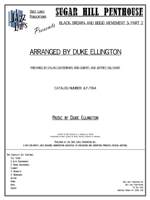BLACK, BROWN, AND BEIGE - MOVEMENT 3, PART 2: SUGAR HILL PENTHOUSE
Arranged by Duke Ellington, Prepared by Dylan Canterbury, Rob DuBoff, and Jeffrey Sultanof

Cat #: JLP-7364
$75.00This item usually ships within 1 business day.
Questions?
Please call +1-518-587-1102 or email us.
Edition: Jazz Big Band Arrangement
Description: Swing - Difficult
Publisher: Jazz Lines Publications
Originally, "Sugar Hill Penthouse" was titled "Symphonette" before it was incorporated into the third movement of Duke Ellington's "Black, Brown, and Beige." The re-titling is certainly appropriate, as the relaxed tempo, warm harmonies and overall softer dynamics establish an atmosphere as cozy and inviting as the section's namesake.
A brief Ellington stride piano solo serves as the introduction before the spotlight switches to Harry Carney, this time making a rare appearance on clarinet rather than his traditional baritone saxophone. His resonant, woody tone does a stellar job of accentuating the pretty melody, especially when playing in the instrument's lower register. The volume stays largely low until measure 28, where a sudden brass swell and fanfare breaks things up a bit before Carney's solo comes to a close.
An a capella figure in the muted trumpets leads to a pleasant full band section before Carney's clarinet returns at measure 58, this time serving as the lead voice of the woodwind section. A key change four measures later marks the shift of the spotlight to the brass, with the trumpets playing a unison melody with fairly syncopated accompaniment from the trombones. The band reaches its dynamic peak with the woodwinds' re-entrance at measure 78. The ensemble writing is also easily at its most intense during this section, with all three sections of the band weaving in and around each other.
A saxophone trill and some blunt triplet honks in the brass, followed by a gong hit from drummer Sonny Greer, marks a return to the arrangement's more demure musical origins. The woodwinds (still led by Carney's clarinet) take the forefront for the rest of the section, playing a disarmingly lovely melody that comes to a conclusion that can work either as a stand-alone performance or a smooth transition into the final movement. Note that this section was written for only three trumpets.
Sugar Hill Penthouse begins at 7:23 in the below clip.
2 Alto Saxophones
2 Tenor Saxophones
Clarinet
3 Trumpets
3 Trombones
Guitar
Piano
Bass
Drums
Trombone 1: Bb4







![MOOCHE, THE [DOWNLOAD]](https://www.ejazzlines.com/wp-images/product/thumbnail/28046-s.jpg)

